For all its modernity and dynamism, Hong Kong’s culture and society are underpinned by a strong foundation of traditional Chinese values and beliefs. The Confucian concepts of humility, perseverance, reverence for ancestors and respect for elders have been adapted to its modern, capitalist society. Confucius said that a person should always examine motives carefully before acting, since all individuals are directly responsible for their fate. As the teachings of the great sage permeated into Chinese society over the centuries, this has led to a belief that anything can be achieved through sheer will and hard work. The attitude is, “If you don’t have any money, then go out and earn some!” rather than relying on government support or charity to provide financial assistance.
With this work ethic in mind, many parents work at least nine or ten hours a day, six days a week to provide for their children who will, one day, look after them in old age. Most of the family budget goes towards children’s clothing, healthcare and education, so that they may enjoy what their parents never had in their youth. Children are expected to support their elderly parents and to honour the memory of deceased parents by regularly visiting their graves and making offerings.
Family values are very strong, and parents dote on their children by spending time and money on them. On Sundays and holidays, parents take the whole family, with grandparents in tow, for Western-style buffets or dim sum. After lunch, families wander around the streets and shopping malls, buying new toys and clothes for the children.
What’s in a name?
One of Hong Kong’s odder cultural quirks is the range of eccentric English nicknames chosen by the Hong Kong Chinese: Biscuit, Photosynthesis, Frandie, Wealthy, Xerox, Tweetie… This is in part the result of a desire to embrace the English-speaking world, and in part a way of identifying with a particular respected figure, a hobby or interest.
Emulation of the famous and successful accounts for the plethora of Jackie Chans in the territory, and may also explain some of the Wilsons – after the colony’s penultimate British governor. Seemingly gauche names such as Lucky or Wealthy or the no-nonsense Money represent the aspirations of a people who have only enjoyed prosperity for a couple of generations.
Humour is apparent with names that echo the individual’s Chinese name, such as Winky Wong (a version of Wong Wing-kee that has been used by more than one Hong Konger). Sometimes the name puns on the family name, as in Gypsy Lee or Ivan Ho. Hobbies or interests can play a role, scientific processes clearly being of fascination to Photosynthesis Wong. Fandie, Ankie and Banda represent a desire to be the only person in the entire world to have a certain name. And then there are the downright peculiar but memorable, such as Onions, Squash or Catherine (a man).
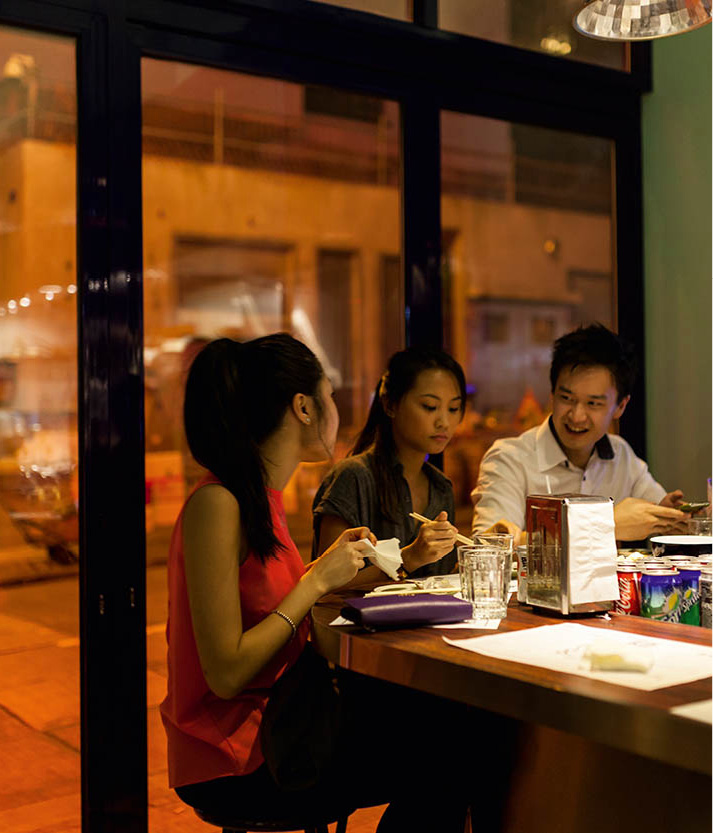
Affluent young Hong Kongers.
Ming Tang-Evans/APA Publications
Money and status
Successive famines, wars and political upheaval in China have taught the Hong Kong Chinese not to be complacent about financial security. They are eagle-eyed at spotting opportunities for making money; here “filthy lucre” really does seem to buy happiness, since material security is vital to one’s sense of well-being. There is no other place in the world where people, rich or poor, are as business-minded and clued-up about property, stocks and horse-racing. It’s no coincidence that kung hei fat choi – literally “congratulations on your wealth” – is a common greeting at Lunar New Year. As in most places in the world, of course, the quest for wealth is also motivated by self-respect or “face”. Wearing designer labels and buying expensive dishes in a restaurant, such as lobster, abalone and shark’s fin, are all ways of showing you have wealth. At the end of a meal, diners will fight to pay the bill, since generosity also gains face. Face and guanxi – lifelong obligations of mutual assistance – are crucial to relationships. That’s why the Chinese prefer to give business to family and friends rather than deal with strangers, who might prove to be unreliable. In friends there is certainty.
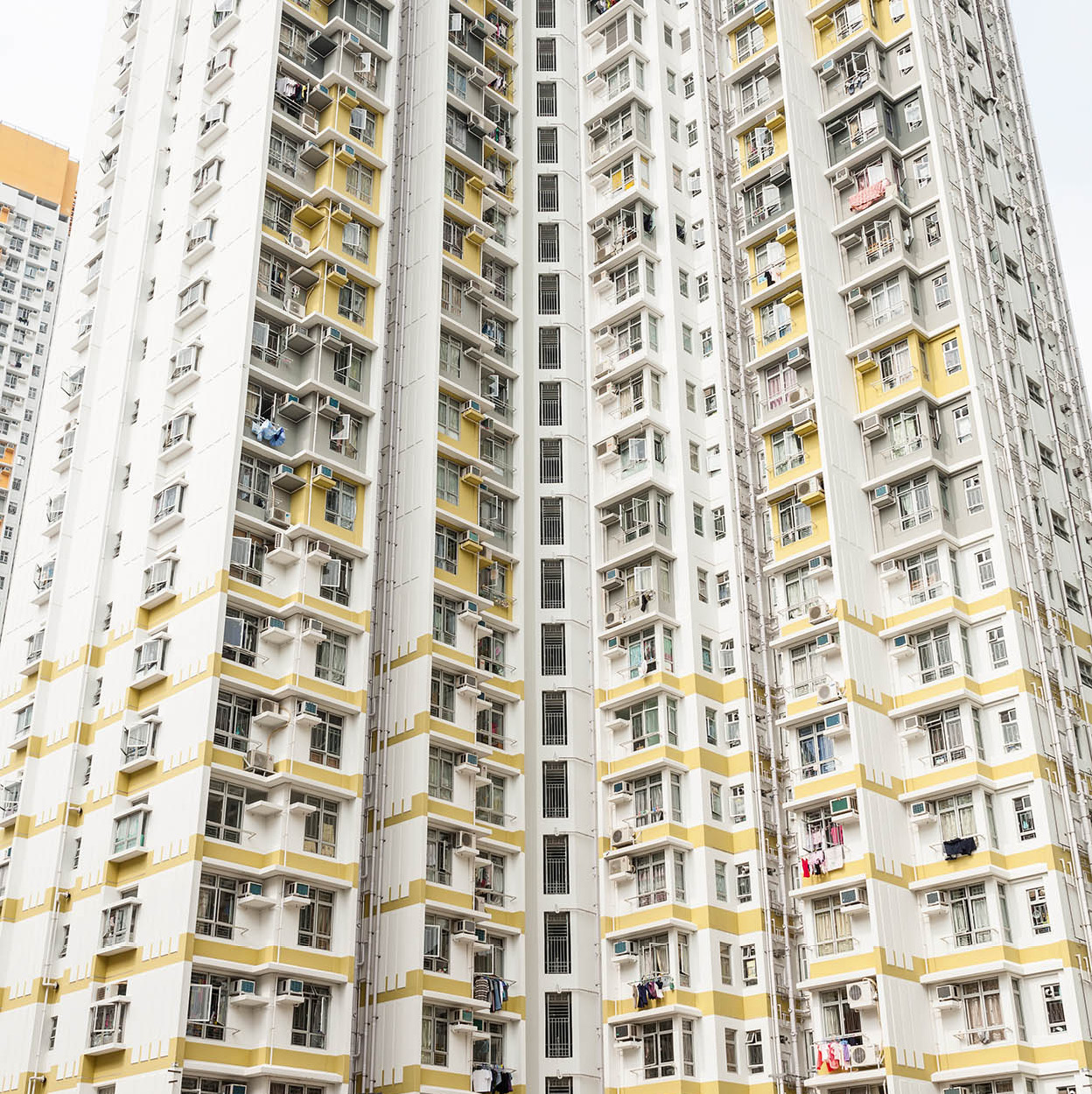
Hong Kong has one of the world’s highest population densities and most people live in public housing.
Ming Tang-Evans/Apa Publications
The public persona
Many foreigners visiting Hong Kong have complained that the people are sometimes brusque to the point of rudeness. This has often been a result of cultural misunderstandings, but not always. Hong Kong does not have the “have a nice day” culture, and chit-chat about the weather seems unnecessary when there’s business to be done. Even so, there has been a campaign to improve politeness to meet tourists’ expectations. The customer service in many of Hong Kong’s hotels and restaurants is second to none.
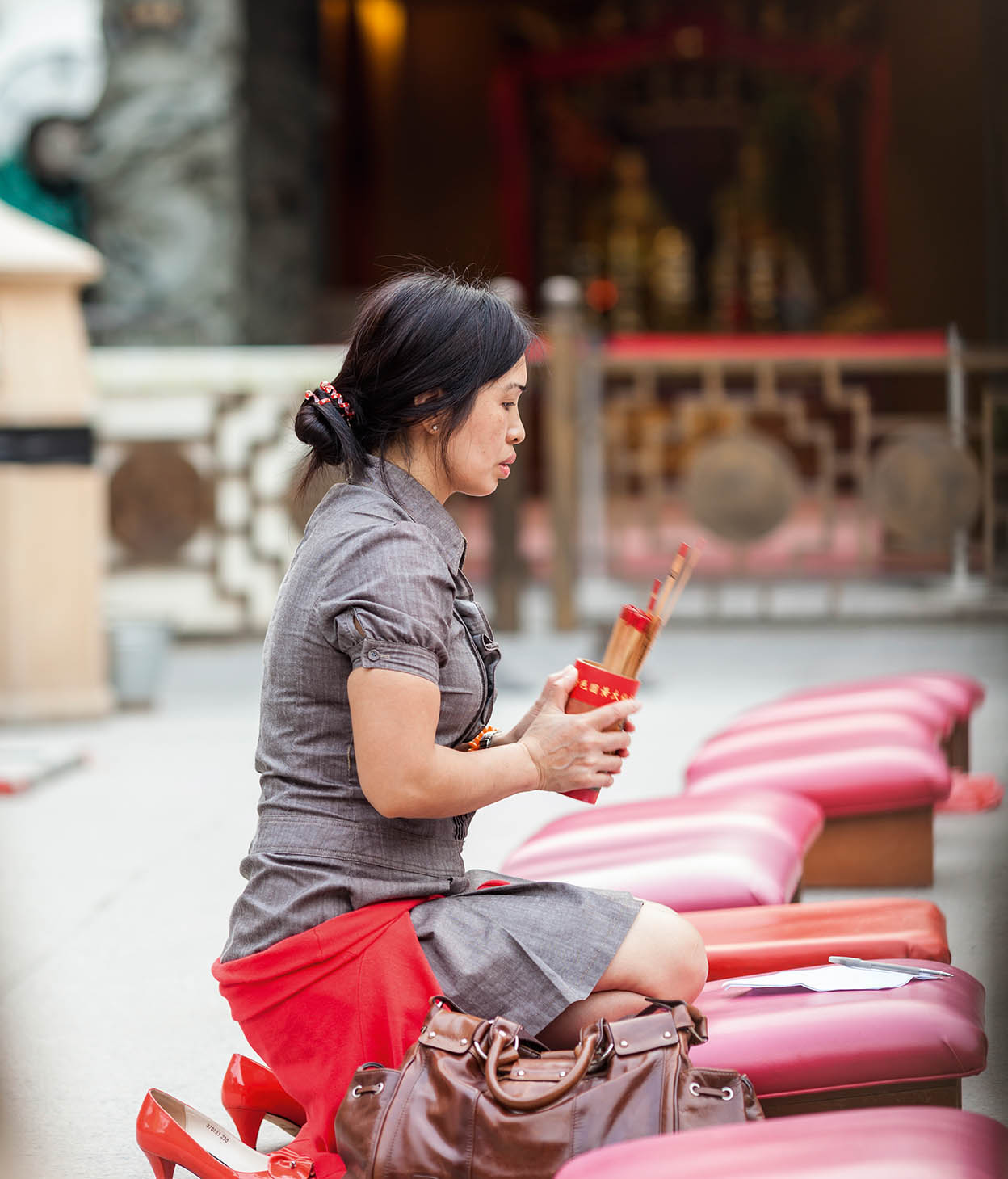
Laying offerings at Wong Tai Sin Temple.
Ming Tang-Evans/Apa Publications
Property and the cost of living
For financial reasons, Hong Kongers often marry later than mainland Chinese – for women, 29 is a typical age, for men, 31. Because of high property prices, most people, even married couples, have no choice but to live with their parents until they have saved enough money. Cramped living conditions, however, make life difficult for would-be lovers. Moments alone are rare, and the prying eyes of relatives are not conducive to romance. People often socialise in large mixed groups; parks are few and far between, so busy anonymous places such as malls or large theme parks offer a chance to to be alone.
Lack of space
Hong Kong is one of the world’s most crowded environments, with correspondingly expensive property and often cramped living conditions. Over half of Hong Kong’s population lives in public housing, where families benefit from low rents (the average monthly rent for public housing is HK$1,540) as well as shared income from family members, and are thus relatively well-off compared to low-income families in other parts of the world. However, lower-middle-class families are often caught: they do not qualify for public housing, and most property prices are way beyond their budget. The average apartment is just 500 sq ft (48 sq metres), enough for a living area, small kitchen and one, sometimes two, small bedrooms.
This is a capitalist society where Darwin’s theory of the “survival of the fittest” predominates. Local tax laws give residents incentive to be among those that not only survive, but thrive. Residents keep most of what they earn – the highest income-tax rate is 17 percent, and only around 2 percent of the working population pays this, with over half paying no income tax at all.
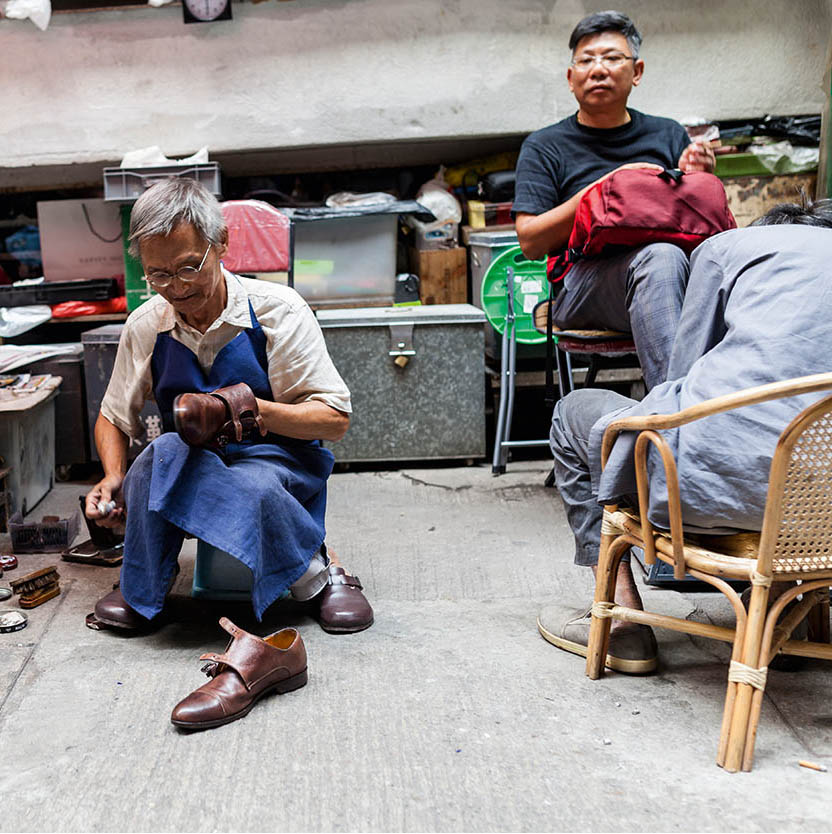
Hustle and bustle is daily life in Hong Kong, but even the busiest people stop for a shoe shine.
Ming Tang-Evans/APA Publications
However, Hong Kong has a high cost of living due to rising inflation, limited land, the expense of importing raw materials and food, and high duties imposed on petrol and cars. On the other hand, there is no sales tax, and public transport is cheap. Luxury goods score high points in the “face” game, and some people will gladly blow all their disposable income on a Louis Vuitton bag even if they can’t then afford much else.
Hong Kong has steadily expanded in area as a total of 70 sq km (27 sq miles) has been reclaimed from the sea. Around 70 percent of this has taken place since 1980.
Land prices have always been high, a result of the shortage of suitable terrain for construction. The government makes huge profits on land sales – a situation which fuels the desire for more and more land to be reclaimed from the sea. The largest and most successful Hong Kong companies, such as Cheung Kong and Sun Hung Kai, have built their fortunes upon this system.
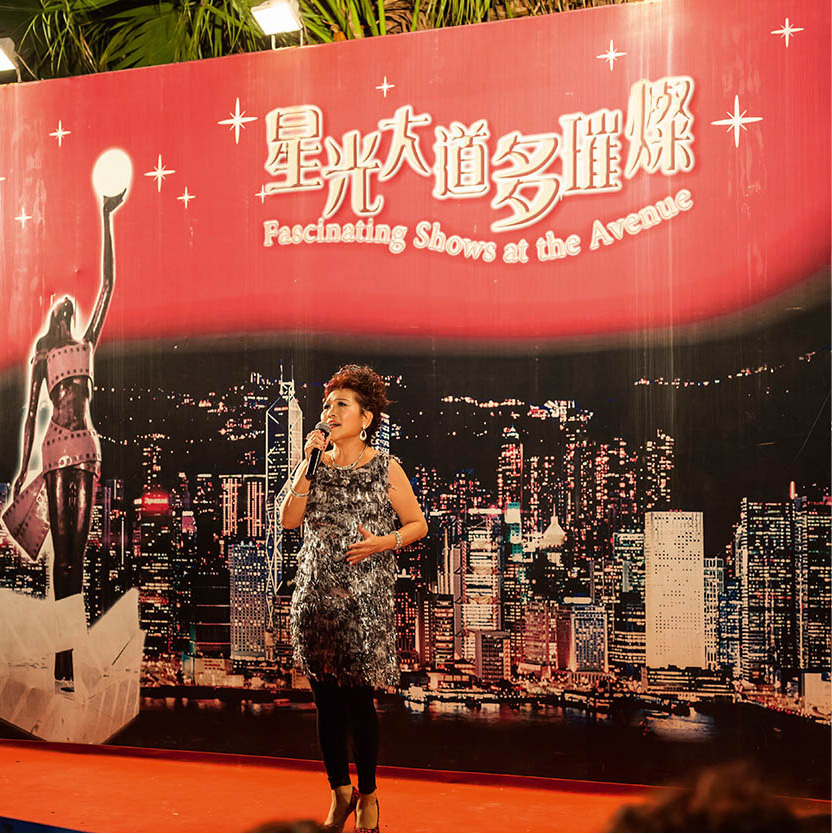
Performance at the Avenue of Stars, which is modelled on the Hollywood Walk of Fame.
Ming Tang-Evans/Apa Publications
Social welfare and health
Hong Kong may be one of the world’s wealthiest cities, but not all share in its prosperity. An estimated 150,000, mostly elderly people, live in inadequate housing, with the worst-off in shacks or so-called “cages” (with room for a bed and nothing else, and usually packed several to a room), or out on the streets.
There is a welfare system for the elderly, with payments of HK$2,590–3,140 per month. The Mandatory Provident Fund introduced in 1999, forces employees to invest up to 5 percent of their salary for retirement when the fund can be withdrawn as a lump sum.
Primary medical care is largely taken care of by private GPs in Hong Kong, while 90 percent of hospital admissions are at government-subsidised hospitals. The problem of overcrowded public wards and long waiting lists has drawn a great deal of criticism, however, and this has led to substantial growth in private medical insurance funded by both companies and individuals. Many employers offer health insurance to subsidise private healthcare.
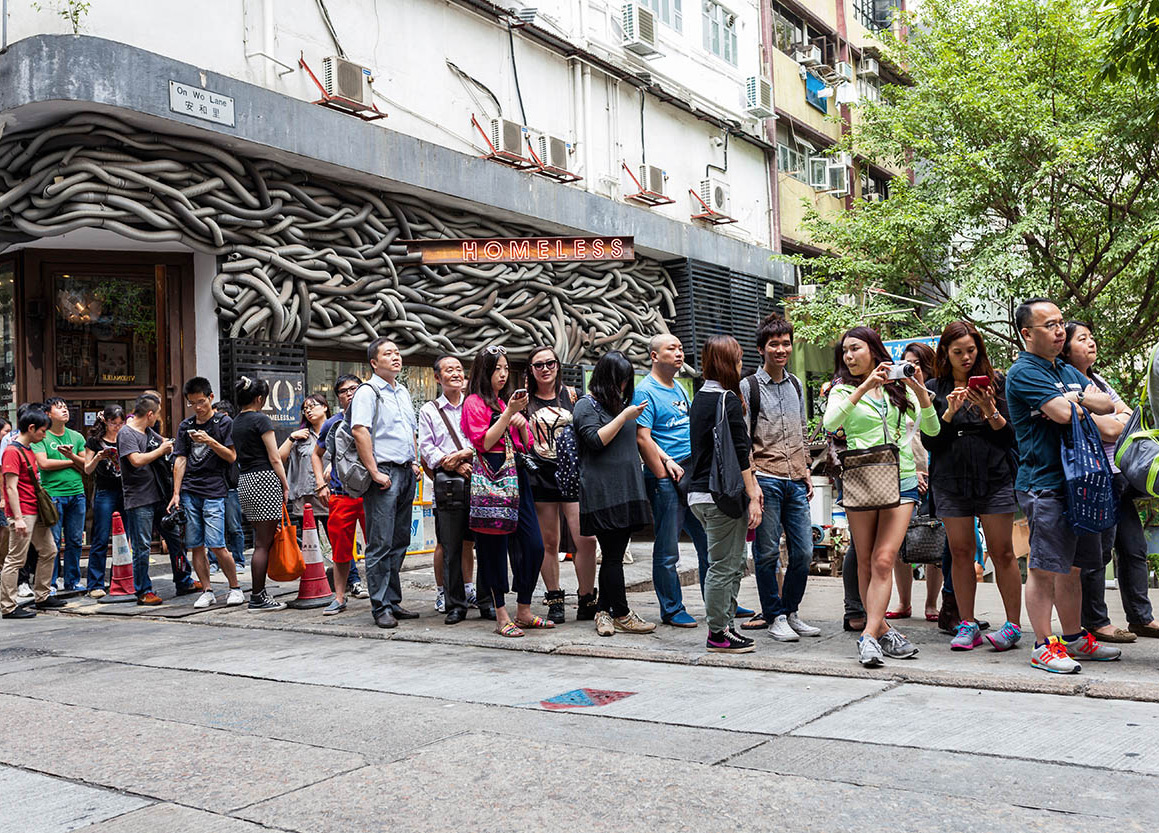
People queuing on Gough Street.
Ming Tang-Evans/APA Publications
Affordable government medical care is currently assured for the entire population through public funds and private donations, but the administration is considering making private health insurance mandatory.
Pollution and the environment
Most visitors to Hong Kong are likely to notice the appalling quality of the air. Hazing out the views from The Peak, on bad days even making it difficult to see across the harbour, the pollution is frequently cited by residents as the worst single aspect of the SAR. Some of the smog is home-grown, but a good proportion is imported – a photo-chemical cloud drifting down on the northeast winds from the industrial zones of Guangdong. These winds are at their most persistent during the October–April period; pollution levels are usually lower between May and September as the wind blows in from the south and east, and heavy rain washes out the dust. Meanwhile, the waters are also filthy, and this and over-fishing has reduced local fish stocks by 80 percent.
In the past few years, these environmental problems have become a hot topic in Hong Kong, and some progress is being made on local emissions – some taxis and buses running on LPG gas, for example. Yet despite a great deal of debate (and protest), there is a lack of will-power from the authorities to do anything about it – partly as a result of a powerful business lobby reluctant to sanction anything likely to cut profit margins.
Crime
Hong Kong’s over-the-top action movies often give the impression of a crime-ridden city which is a perpetual hunting ground for chopper-wielding tattooed thugs and armed robbers. In reality, one of the pleasures of Hong Kong is its lack of crime – the streets are safe at any time, and the chances of being mugged or pickpocketed are significantly lower than almost anywhere in Europe or America. This is often mentioned as a major quality of life benefit, one that encourages expats to live in Hong Kong.
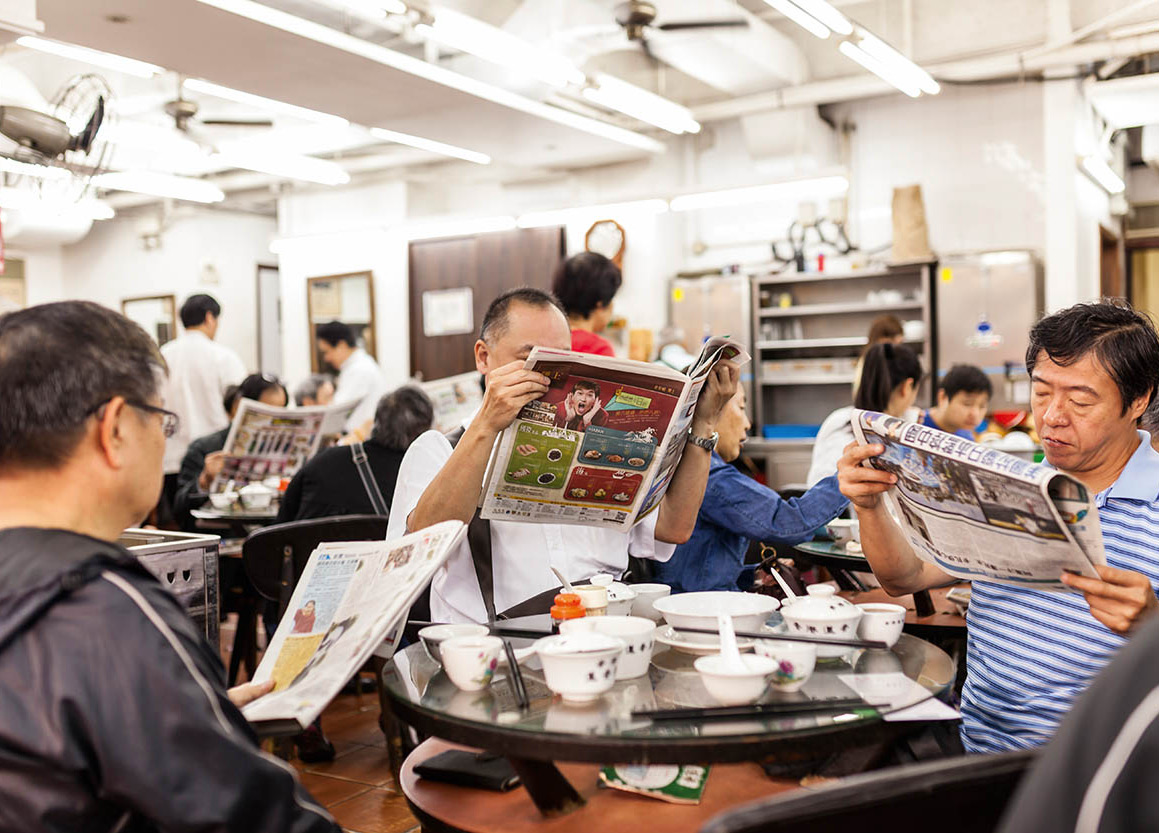
Catching up with the news at Lin Heung Teahouse on Wellington Street.
Ming Tang-Evans/APA Publications
Organised crime does exist, though. The triad crime syndicates rely on a hierarchical structure, with ranks denoted by numbers that begin with four, representing the four elements, compass points and seas. The highest-profile gangs are “14K” and “San Yee On”, whose illegal activities include loan-sharking, gambling, narcotics, prostitution, smuggling and extortion.
In 2012, Hong Kong had an estimated 11,000 drug abusers: 53 percent of them are heroin addicts, 35 percent use methamphetamine and 11 percent ketamine. The government takes a tough stance on narcotics. Possession of marijuana carries the same penalties as hard drugs: a criminal record and possible imprisonment. Still, Hong Kong’s “work hard, play hard” culture, coupled with its affluence, has meant that recreational drugs are readily available.
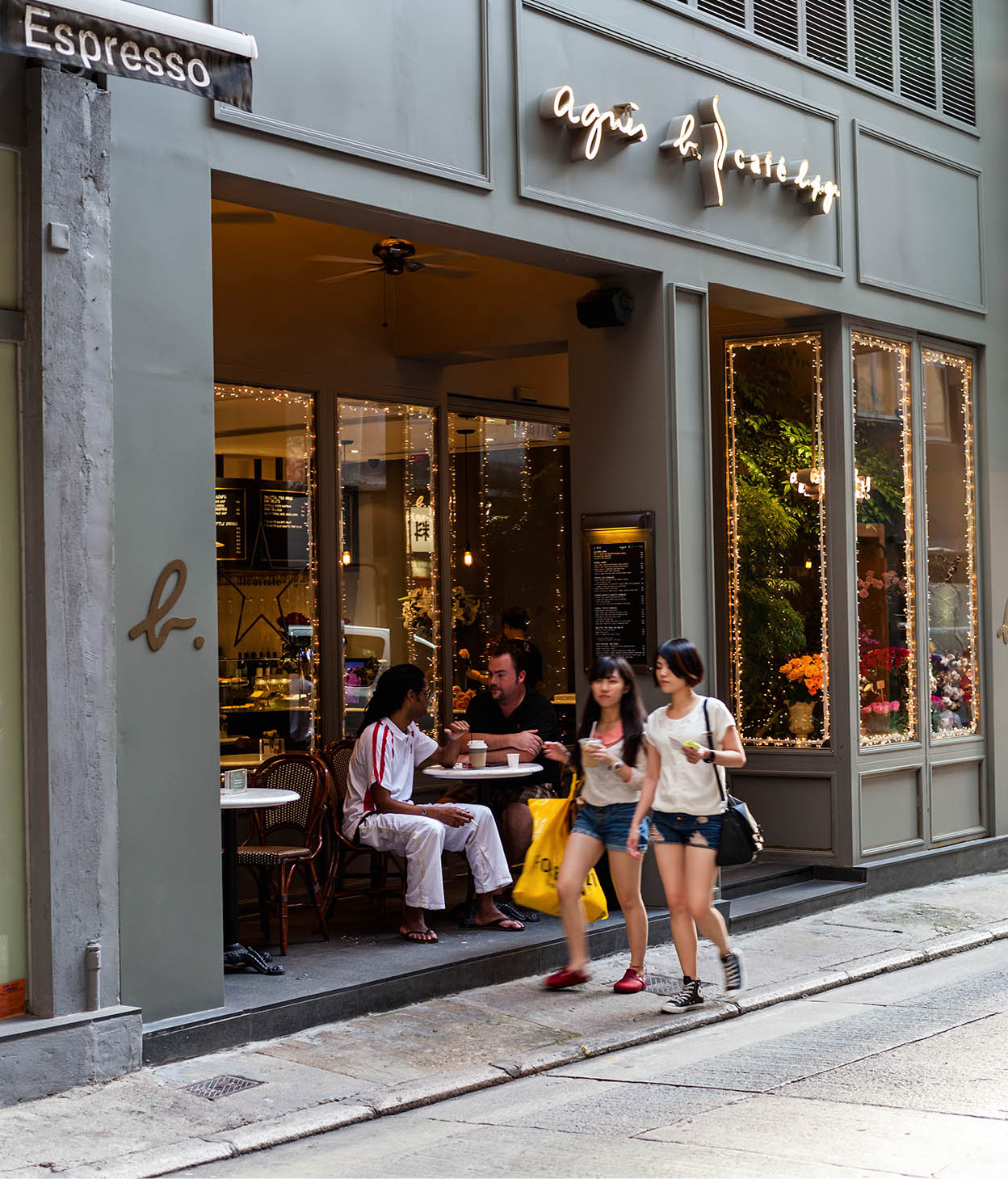
Hong Kongers love to shop.
Ming Tang-Evans/APA Publications
Education
Hong Kong’s educational system is every bit as competitive as its business community. Children suffer great pressure to get into prestigious schools. The most sought-after are English or bilingual schools – English is widely used in business, medicine and law. As elsewhere in the world, some students commit suicide each year if they fail an important exam. Parental pressure often proves too much for children, who spend much of their time cramming for exams and studying foreign languages for overseas study. Tutors are hired to prepare toddlers for kindergarten entrance exams, an ordeal that sometimes requires two hours of testing to determine a child’s Chinese, English and arithmetic skills.
The government regularly carries out studies to ascertain the standard of English spoken by teachers, to ensure that students get every opportunity to become confidently bilingual. The core competency remains Chinese, English and maths, but an overseas education is seen as a passport to a higher salary.
Political awareness
Now that Hong Kong is getting toward its third decade of “one country two systems”, its residents seem to be developing a clearer identity. They are proud of what the city has achieved, and nostalgic about the tough years when they or their parents helped create the economic miracle. There is also an inner conflict between pride in being Chinese and lingering unease at Beijing’s rule.
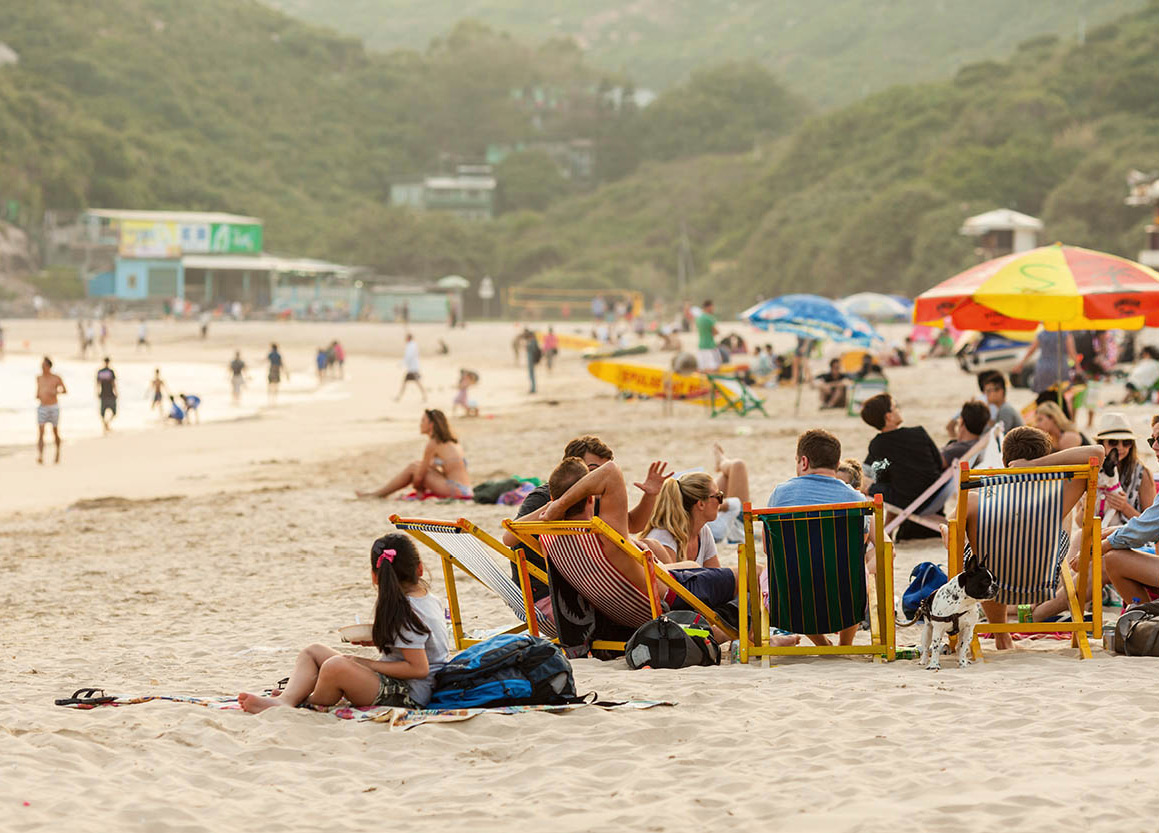
Relaxing on the beach at Shek O.
Ming Tang-Evans/Apa Publications
Self-censorship in some sections of the media is a concern, but locals do voice freely their criticism of the Hong Kong government. There is some frustration amongst ordinary people that certain groups within society wield more influence than others, in particular the tycoons who control the property sector and monopolies. The mess of urban planning, and the issues of harbour reclamation, pollution and a lack of public spaces only adds to public vexation. Yet at the same time these very same tycoons, who have the ear of Beijing, are widely admired for their business acumen and sheer volume of wealth.
Hou q: cute obsession
In tandem with much of the rest of Asia, Hong Kong is in thrall to Japanese pop culture and its obsession with all things cute – what is termed in Japan as kawaii, in Hong Kong as hou Q. The epitome of this is “Hello Kitty”, the ubiquitous cat created by the Japanese company Sanrio which adorns over 20,000 products, from clothing to stationery. Sociologists say the fascination with Japanese style is fuelled by Asians’ need to find a modern image of themselves, to form their own popular culture rather than borrow from the West. Or, as an 18-year-old Hong Konger expressed it: “Japanese society is very fast-paced and always changing. Everything is very cute and stylish”.
In the last few years, political awareness has developed, and street protests have become a regular feature as local people have grown increasingly frustrated with the SAR government’s decisions. There is a keen sense of injustice, yet by and large, people do not appear to associate this with the lack of accountability of a largely appointed administration.
The future
Hong Kong’s economic success can be credited above all to one thing: its industrious people. As Beijing is well aware, any attempts to restrict freedoms could result in an exodus of a talented, highly educated workforce, with disastrous consequences for China. Most China-watchers believe that for Hong Kong to continue to thrive, it is here that China’s economic reforms must coincide with the advance of democracy rather than its suppression. The concern that Shanghai could take over Hong Kong’s privileged position as the gateway to China is voiced less often now, and some influential groups look to a future where Hong Kong forms a giant megalopolis with Shenzhen.
Chinese arts and crafts
Untainted by the communist dogma that justified ransacking cultural treasures during Mao’s mainland rule, Hong Kong is regarded – alongside Taiwan – as one of the purest repositories of traditional Chinese culture and art.
Chinese arts and crafts have a long history. Traditional forms include porcelain, embroidery, brocade, carpets, jade products, carvings (wood, bamboo and ivory) and paper decorations called “scissors-cuts” all with different styles and regional influences as well as brush painting and calligraphy. In Hong Kong, the most reliable places to buy these items are the China Arts and Crafts shops and the Chinese Products department stores on Hong Kong Island and Kowloon. For antiques, look no further than Hollywood Road and neighbouring Upper Lascar Row (more commonly known as Cat Street; for more information, click here).
Fine products
Chinese embroidery and brocade have had a reputation for excellent quality since the days of trade on the Silk Road. The best silk products come from eastern regions where the climate is suitable for raising silkworms, while the dry northwestern regions of the country produce fine-quality cashmere.
Silk embroidery from Suzhou, near Shanghai in eastern China, is especially well known for its fine workmanship and venerable history stretching back over 2,000 years. Drawn work from Shantou in eastern Guangdong also enjoys a good reputation overseas.
Scissors-cut is traditionally a product of rural China, where various kinds of colourful designs are created to decorate windows before Chinese New Year. Patterns include animals, fruit, flowers and characters from ancient Chinese folk tales or operas, often with themes of good harvests, prosperity and happiness.
Carvings of jade, ivory, wood, bone, rock and bamboo are a familiar sight in China. The best-known are jade carvings from Beijing, an art form that dates back to the Ming dynasty (1368–1644); ivory balls featuring legendary Chinese figures from Guangzhou; stone carvings from Shoushan in Fujian province; bamboo carvings from Huangyan in Zhejiang province; and high-quality ink-slabs made in Duanxi and Zhaoqing in Guangdong.
The Chinese invented porcelain in the 7th century AD, a good 1,000 years before Europeans managed to unlock the secret. The best variety comes from Jingdezhen County in Jiangxi province fine, smooth and reminiscent of the ceramics made during the Yuan dynasty. Closer to Hong Kong, the ceramics produced at Shiwan (for more information, click here) are renowned for their quality.
Chinese landscape painting and calligraphy are generally mounted on a hanging scroll. In days gone by, the scroll was rolled up, stored away, and brought out on special occasions to be slowly unfurled, revealing only parts of a scene, subtly drawing the observer into the picture. Miniature paintings on shells, feathers, tree bark, deer horns and even thin strands of wheat straw are also popular souvenirs and gifts.
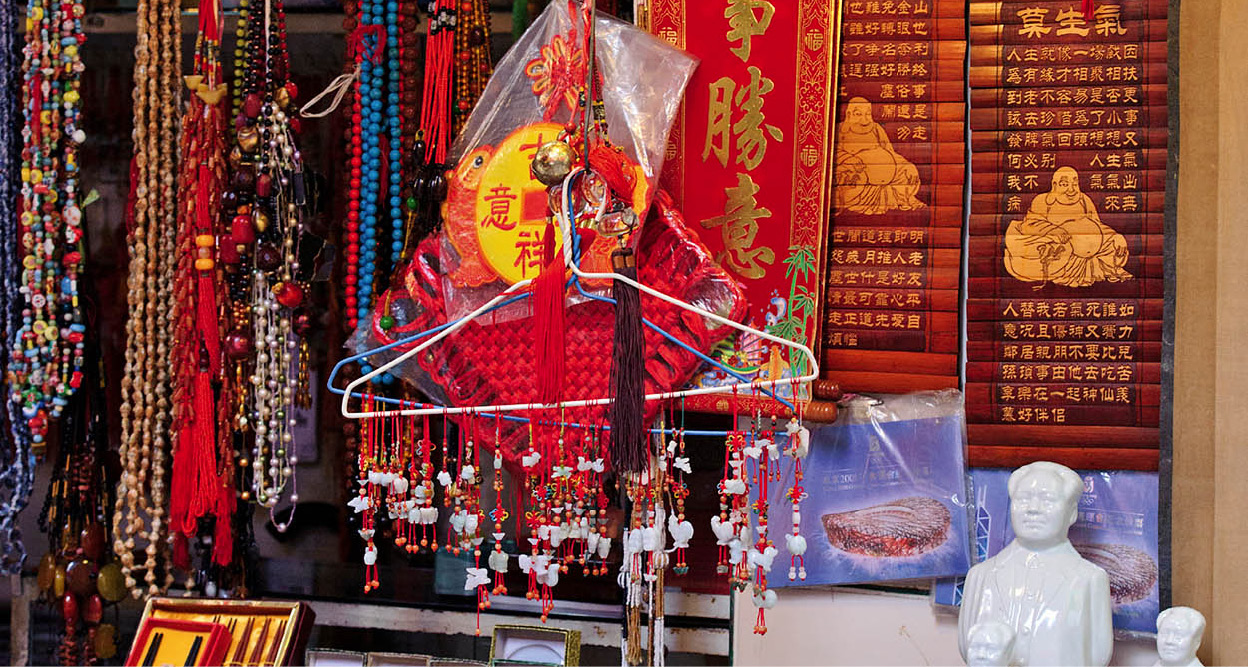
Cat Street market is well known for its assortment of antiques and bric-a-brac.
iStock